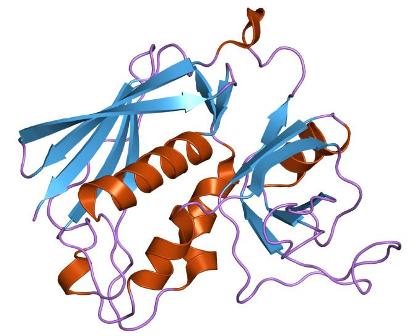Toxicology
This organism is capable of producing cytotonic enterotoxins,
Alt and Ast, as well as the cytotoxic enterotoxin (Alt).
Enterotoxins are toxic proteins that specifically affect the
intestinal lining.
 Cytotonic enterotoxins more specifically
change the morphology of the cell, but do not kill the cell. For
example, they are able to lyse red blood cells, destroy tissue
culture cell lines, evoke a fluid secretory response in ligated
intestinal loop models, and induce lethality in mice. In
contrast, cytotoxic enterotoxins result in cell death.
Cytotonic enterotoxins more specifically
change the morphology of the cell, but do not kill the cell. For
example, they are able to lyse red blood cells, destroy tissue
culture cell lines, evoke a fluid secretory response in ligated
intestinal loop models, and induce lethality in mice. In
contrast, cytotoxic enterotoxins result in cell death.
Alt is composed of a single polypeptide chain
with 368 amino acids. This enterotoxin is homologous to the Alt
enterotoxin in
E. coli. Ast is a heat-stable cytotonic enterotoxin, having the least
significant effect on fluid secretion compared to Alt and Act.
It is also a single polypeptide chain made up of 636 amino
acids.
Act, the pore-forming cytoxic enterotoxin contributes the
greatest to fluid secretion out of the three toxins.
In fact, it is so significant that the amount of Act secreted is
most strongly related to the extent of tissue damage in the
host. Thus, the more bacteria present at the site of injury, the
greater the infection. However, out of all infections caused by Aeromonas hydrophila,
Act is only secreted about 50% of the time while Alt and Act are
secreted in 100% of infections. In intestinal infections, Act is most
closely related to the symptomatic presence of bloody diarrhea.
In other sites of infections, this enterotoxin can be lethal at
certain doses. As an aerolysin toxin, it is able to kill host
cells by forming discrete channels in the plasma membranes of
host cells. Since this toxin is able to kill tissues, especially
in wound infections, it can cause the formation of gas gangrene
which can be fatal to the host. The formation of gas gangrene in
Aeromonas hydrophila is not common, but has been reported
several times in clinical reports. The genus
Clostridium more frequently causes the formation of gas
gangrene. As dangerous as this particular infection can be, it
is not very common.
secreted about 50% of the time while Alt and Act are
secreted in 100% of infections. In intestinal infections, Act is most
closely related to the symptomatic presence of bloody diarrhea.
In other sites of infections, this enterotoxin can be lethal at
certain doses. As an aerolysin toxin, it is able to kill host
cells by forming discrete channels in the plasma membranes of
host cells. Since this toxin is able to kill tissues, especially
in wound infections, it can cause the formation of gas gangrene
which can be fatal to the host. The formation of gas gangrene in
Aeromonas hydrophila is not common, but has been reported
several times in clinical reports. The genus
Clostridium more frequently causes the formation of gas
gangrene. As dangerous as this particular infection can be, it
is not very common.
It is possible that a strain of Aeromonas hydrophila with the
Act, Alt, and Ast genes deleted could serve as a potential
vaccine in the future.
Next page: Host
Interactions
To return to the home page, click
here.